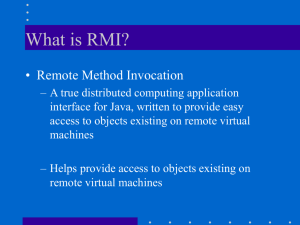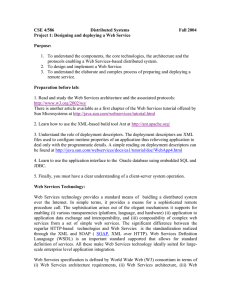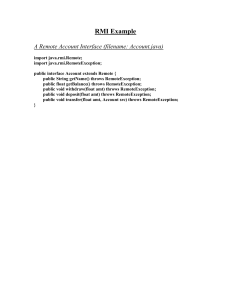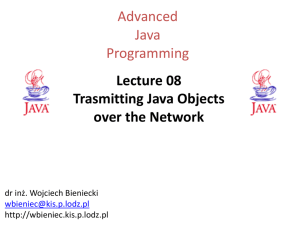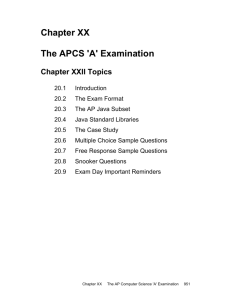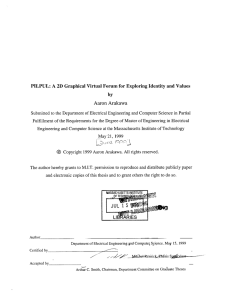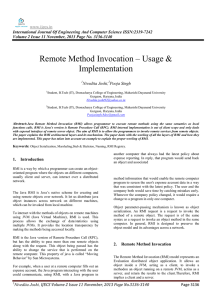BSC P2 2010
advertisement
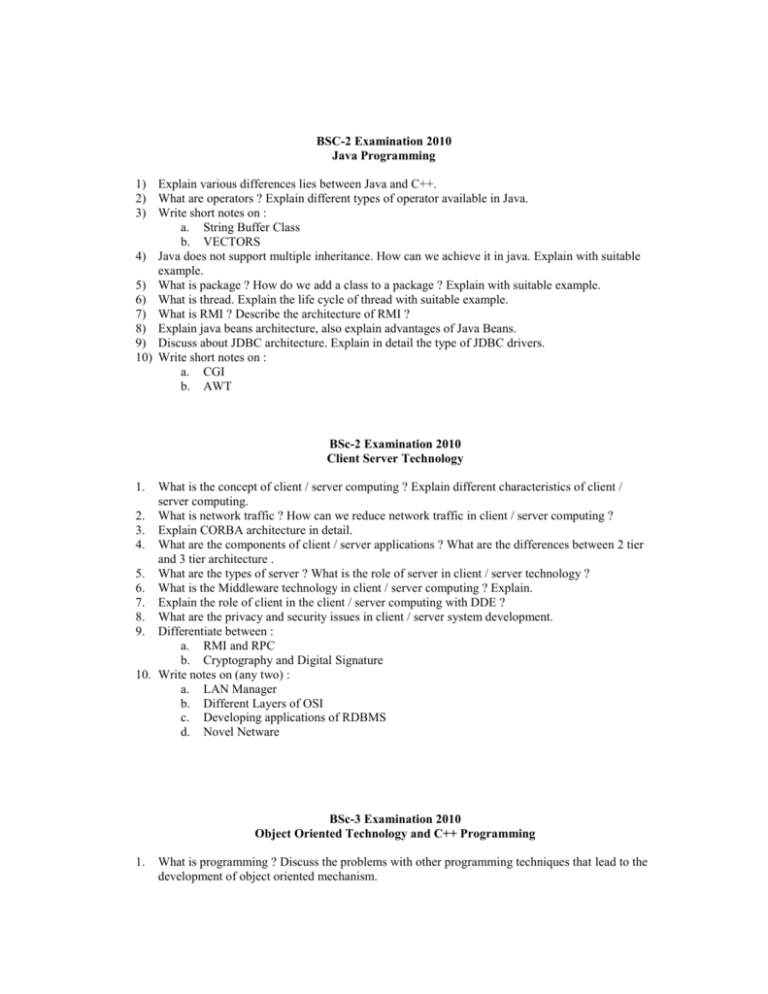
BSC-2 Examination 2010 Java Programming 1) Explain various differences lies between Java and C++. 2) What are operators ? Explain different types of operator available in Java. 3) Write short notes on : a. String Buffer Class b. VECTORS 4) Java does not support multiple inheritance. How can we achieve it in java. Explain with suitable example. 5) What is package ? How do we add a class to a package ? Explain with suitable example. 6) What is thread. Explain the life cycle of thread with suitable example. 7) What is RMI ? Describe the architecture of RMI ? 8) Explain java beans architecture, also explain advantages of Java Beans. 9) Discuss about JDBC architecture. Explain in detail the type of JDBC drivers. 10) Write short notes on : a. CGI b. AWT BSc-2 Examination 2010 Client Server Technology 1. What is the concept of client / server computing ? Explain different characteristics of client / server computing. 2. What is network traffic ? How can we reduce network traffic in client / server computing ? 3. Explain CORBA architecture in detail. 4. What are the components of client / server applications ? What are the differences between 2 tier and 3 tier architecture . 5. What are the types of server ? What is the role of server in client / server technology ? 6. What is the Middleware technology in client / server computing ? Explain. 7. Explain the role of client in the client / server computing with DDE ? 8. What are the privacy and security issues in client / server system development. 9. Differentiate between : a. RMI and RPC b. Cryptography and Digital Signature 10. Write notes on (any two) : a. LAN Manager b. Different Layers of OSI c. Developing applications of RDBMS d. Novel Netware BSc-3 Examination 2010 Object Oriented Technology and C++ Programming 1. What is programming ? Discuss the problems with other programming techniques that lead to the development of object oriented mechanism. 2. Discuss the principles of abstraction. How do we achieve this in OOP ? Discuss class declaration with an example. 3. Discuss the structure of a C++ Program, using an example. What is a compile time error and what is a runtime error. Give an example of each. 4. Write a program in C++ that reads the users age and then print “You are a child” if age<18, “You are an adult”, “You are a senior citizen” if age > 65. 5. Define a function and describe their usage in C++. How do we use the built in functions of C++. Discuss the steps in writing a user defined function. 6. What are the advantages of putting function definition in a separate place/file ? What are the advantages of compiling a function separately ? Discuss the difference between function definition and declaration using example. 7. What is an array ? Discuss its usage in C++ using a program example. What happens if the array initializer has more values then the size of array ? 8. What is a pointer ? How do you access the contents of a memory location whose address is stored in a pointer variable ? 9. Write a short notes on any two : a. Constructors b. Destructors c. Dynamic Memory Location 10. i) What is a inheritance ? Discuss multiple inheritance. ii) Write a note on overloading a function and explain using a C++ program example. BSc-2 Examination 2010 Computer Oriented Statistical Methods 1. a) What do you mean by ‘approximate numbers’ and ‘significant digits’ ? Find the number of significant digits in each of the following : a. 0.000573 b. 153000 c. 0.0004572 * 103 b) Discuss the various types of errors that occur while performing numerical computations. What measures can be taken to improve the accuracy in numerical computation ? 2. a) Factorize the matrix A= as a product of unit lower triangular and upper triangular matrices. b) Express the matrix A= As a sum of a symmetric and a skew symmetric matrix. 3. a) if A= 2 1 2 3 0 0 2 0 2 and B= 2 1 2 3 0 0 2 0 2 Then form the product AB and BA. 2 0 2 b) if A= 4. 4 1 2 3 1 -1 and B= 1 0 0 6 2 1 4 3 2 then prove that (A+B)’ = A’ + B’ where desh (‘) represent the transpose of the corresponding matrix. (a) Compute the inverse of the matrix 3 2 1 2 1 3 4 1 5 (b) Find matrices A,X and B, if the system of equations : x+3y+z=-6 y+3z=-2 x+5y=11 can be written in the form A×=B. 5. (a) Find a root of the equation x3-x-1=0 lies in [1,2] by using Bisection Method correct in two decimal places. (b) Find a real root of the equation : x3+x2-1=0 on the interval [0,1] by using the method of successive approximations correct to three decimal places. 6. Use the Newton Raphson method to find a root of the equation x3-4x2+x+6=0 correct to three decimal places. 7. Solve the following system of equations : a. 2x + y + z=10 b. 3x + 2y + 3z=18 c. x + 4y + 9z=16 using the Gauss-Elimination Method. 8. 9. Compare and contrast between : a. Gauss elimination and Gauss-Jordon method of solving system of linear equations. b. Jacobi’s method and Gauss-Seidel iteration method of solving system of linear equations. (a) Find the number of men getting wages between Rs. 100 and Rs. 150 from the following table : Wages (in Rs.) 0-100 100-200 200-300 300-400 No. of men 9 30 35 42 (b) Given f(1.15)=1.0723, f(1.20)=1.0954, f(1.25) = 1.1180, f(1.30) = 1.1401. Find f(1.28) using Newton’s Backward Interpolation Formula. 10. a) Appy Gauss Forward Difference Interpolation formula to find y9, given that y0=14, y4=24, y8 = 32, y12=35, y16=40. b) Find the sales of a concern for the year 1986 using Gauss Backward Difference Interpolation formula given that : Year : 1951 1961 1971 1981 1991 2001 Sales : (In thousands) 12 15 20 27 39 52 B.Sc.-2 Examination 2010 Computer Graphics 1) Explain application and advantages of computer graphics. 2) Differentiate between : a. Cathode Ray Tube and Refresh Cathode Ray Tube b. Random-Scan and Raster-Scan display 3) Explain various softcopy output devices used in Graphics. 4) Differentiate between : a. Impact and non-impact printer. b. Flat bed and drum plotters 5) Describe scan-line seed fill algorithm with the help of suitable example. 6) What is the difference between WAV and MIDI files. What is the role of sound card. 7) In 3D view what is the use of virtual reality and work stations. 8) Give a clipping window p(0,0), Q(30,0), R(30,20) S(0,20) use algorithm to determine the visible portion of the line(10,30) and B(40,0). 9) A polygon has four vertices located at A(20,10), B(60,10), C(60,30) and D(20,30). Indicate a transformation matrix to double the size of the polygon with point A located at the same place. 10) Explain various geometric transformations. BSc. Part-2 Examination 2010 System Analysis And Design 1. What do you understand by Program Development Methodology ? Describe each step involved in Program Development Methodology. 2. 3. Discuss the importance of : a. Flow Chart b. Debugging c. Walkthrough (a) Discuss the various aspects while designing the Record Design and File Design. (b) Discuss the need of System Development Life Cycle (SDLC). 4. (a) Discuss the advantages of fourth generation language with suitable examples. (b) Discuss the need of structured programming. Discuss in detail. 5. Write short note on the following : i) Documentation ii) Data Dictionary iii) Project Management 6. Differentiate between : i) Top Down and Bottom Up approach ii) Flow chart and Pseudo Code 7. Data Processing is important task in major organization, discuss the processes involved in Data Processing in any organization. 8. Use acceptance is very Crucial Phase in System Analysis and Design, discuss the various aspect in user involvement in acceptance string. 9. Write short note on the following : i) Normalisation design of input ii) Tools for Documentation 10. Data Flow Diagram is treated as structured tool in System Analysis and Design, describe the various symbols used in DFD. Also Prepare detailed DFD for online Air Ticket Reservation.





